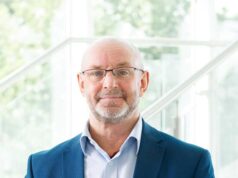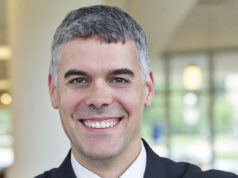In the first years of the 20th century, Dr. Alexis Carrel (1873-1944) introduced three-point end-to-end vessel anastomosis, a technique that revolutionized vascular surgery. His method, still in common use today, helped earn him the 1912 Nobel Prize in Physiology or Medicine and has led many to call him “the father of anastomoses.”
Dr. Carrel was not only the youngest person to ever be awarded the Nobel Prize, but he was also the first Nobel winner whose work was primarily performed in the United States—even though he was a native Frenchman who emigrated from Lyons and maintained his French citizenship.
The inspiration for his work in vascular repair has been traced to the assassination of French President Sadi Carnot, who was stabbed in the abdomen in 1894. Carnot’s physicians made no attempt to repair the lacerated portal vein, and Carrel criticized them severely after the fact. Nearly all physicians at the time would only ligate—not attempt to repair—blood vessels, which meant that survival or preservation of limbs was possible only in cases of damage to vessels that had duplicates, such as those distal to the knee or elbow. Dr. Carrel argued with his superiors that the portal vein should have been repaired, and the incident “inspired him to begin his historic research in vascular anastomosis,” according to Dr. Catherine Boulay and Dr. Mark A. Hardy (Current Surg. 2001;58:300-9).
In 1902, Dr. Carrel published his most important—and still used—technique of vascular anastomosis. (See box.) Although the majority of his work was done on experimental animals, he and others rapidly adapted it for use in humans. In his Nobel presentation speech, Prof. J. Ackerman, a member of the committee on medicine or physiology, stated: “Alexis Carrel was the first person to invent a better and more reliable method of sewing vessels together.. . . [When he made a suture, he] enlarged the opening using three retaining stitches located at equidistant points which converted the round opening into a triangular one.” The key benefit of this technique was its ability to prevent thrombosis and infection.
Interestingly, the method relied not only on Dr. Carrel’s profound skill as a surgeon, but on the help of his mother’s embroidery circle. He “adapted fine lace needles and silk embroidery thread for use in delicate surgery.”
His method was quickly adapted to the performance of routine anastomoses in vessels ranging from major arteries to minor veins. The technique formed the basis for bypass surgery, and allowed the use of graft vessels from donors or other parts of the body, or artificial implants. Still later, his anastomosis technique would become the foundation for revascularizing organs during transplant, work that Dr. Carrel pioneered in animal experiments.
In his career, Dr. Carrel also helped to make major advances in the area of heart surgery. He collaborated with Dr. Theodore Tuffier, describing procedures for mitral valvulotomy, annuloplasty, and coronary artery bypass graft at the American Surgical Association meeting in 1910. And in 1935, toward the end of his American career, he—along with aviator and engineer Charles A. Lindbergh—helped create the first pump-oxygenator for organ perfusion, thus laying the groundwork for future heart-lung machines.
Among Dr. Carrel’s many other technical successes was his ability to safely perform complex surgery in the preantibiotic era. During World War I, he returned to France and created a model facility with funding from the Rockefeller Foundation for hospitalizing soldiers close to the front. Working with his nurse-wife and a colleague, Dr. Henry Drysdale Dakin, he devised a wound irrigation solution consisting of sodium hypochlorite (0.45%-0.5%) and boric acid (4%) in order to promote antisepsis.
As part of their methodology, Dr. Carrel and Dr. Dakin monitored wound cultures frequently, and did not close the wound until these cultures came up negative. Dr. Carrel was widely criticized for this procedure, despite his successes, and the method was not adopted until more than a year later by the allied forces. Dr. Carrel then went to New York to train medical officers in the Carrel-Dakin technique.
As he grew older, Dr. Carrel’s interests widened significantly beyond vascular surgery, and he began to focus on cell, tissue, and organ culture. In 1912, for example, he cultured heart cells from a chicken embryo; these were maintained successfully for 34 years, outliving Dr. Carrel himself. He drifted into areas beyond science and became a philosopher, a religious apologist, and an armchair sociologist. His book, “Man, the Unknown” (New York: Harper & Bros., 1935) was an international best seller and caused him endless trouble with his peers.
“Scientists shunned him for his gullibility,” noted Dr. Boulay and Dr. Hardy, because of his support of the study of clairvoyance, telepathy, water divination, auras, and the healing power of prayer.
Even more controversial were his support of eugenics, his belief that democracy was doomed to failure because men were not equal, and his advocacy of euthanasia for criminals and the criminally insane—views that ultimately led many to consider him a Nazi sympathizer.
Dr. Carrel returned to France in 1939, shortly before the start of World War II, when his unpopular views and sometimes abrasive personality helped to keep him from getting a stay of mandatory retirement at age 65 from the Rockefeller Foundation, where he had worked for over 30 years.
Dr. Carrel was known to despise Hitler. But his published views—and the fact that he agreed to work for the Vichy government in occupied France to create and head a new institute of man, called the “Foundation Française Pour l’Étude des Problèmes Humains”—made him suspect. The German propaganda machine embraced Dr. Carrel and his work at the institute, helping to contribute to his vilification in the allied nations. In the backlash after France was liberated, Dr. Carrel was accused of collaboration, his institute was dismantled, his health failed, and he died shortly afterward, on November 5, 1944, all the while fearing arrest as “a racist, a Nazi apologist, and a Nazi eugenicist.”
It was a fate starkly in contrast to his earlier achievements as a pioneer of vascular surgery and organ transplantation.☐
“The love of gain penetrates everywhere.. . . It operates in that great doctor who is always insisting to his pupils and patients the efficacy of some remedy when, all the while, he is being secretly paid by its manufacturers.”
—Alexis Carrel, M.D., in “Reflections on Life” (New York: Hawthorn Books Inc., 1952)
In addition to Dr. Boulay’s and Dr. Hardy’s article, “Alexis Carrel—The French Dervish of Surgery (Current Surg. 2001;58:303-9 [Epub doi:1016/S0149-7944(01)00416-0]), more information about Dr. Carrel can be found in the following sources:
• “Nobel Lectures, Physiology or Medicine, 1901-1921, (Amsterdam: Elsevier Publishing Co., 1967; available online at http://nobelprize.org/nobelfoundation/publications)










